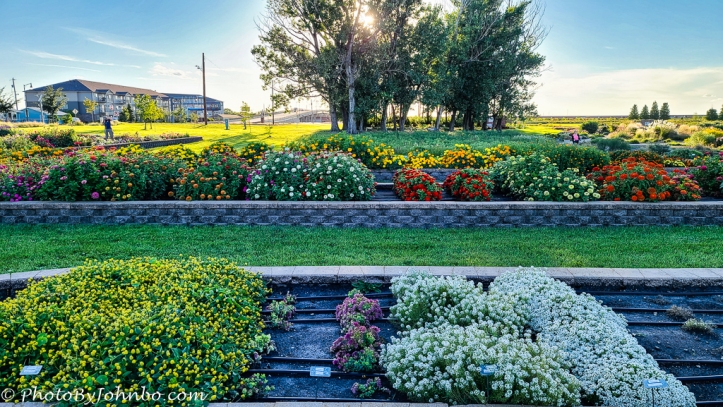
This week, Patti asked us to consider the whole subject and then concentrate on the details. She writes, “Choose a subject (a statue, a person, a place, street art, etc.) and take a series of photos about your subject. Get closer and closer to the subject, focusing on a particular detail(s). Vary your shots by changing your perspective or angle of shooting or even your lens. Post three photos of your subject.” You can read her entire challenge post here.
One of my favorite places in Fargo (in the summertime) is the small botanical gardens at North Dakota State University. I drive by it almost daily, and sometimes I get the urge to stop and smell the flowers (or at least photograph them.) The garden has several dedicated beds that group plants into related categories. My opening photo shows a large portion of the gardens.
The gardens don’t focus only on flowers. One of the gardens features several varieties of regional prairie grasses. As you can see by this photo, the image was captured on a breezy day, a common occurrence in the upper Midwest.
The gardens aren’t typically crowded, but when I pull in and park, there are often one or two cars in the small parking lot. Occasionally, when I visit the gardens, I meet different species, including this chip monk.
Central Park was busy on the Sunday we visited. I found many things to photograph that day that I will share in an upcoming Travel Tuesday post. For this tryptic, I included the above-establishing shot as we walked toward a sculpture gracing Doris C. Freedman Plaza.
I was sidetracked by this pedicab driver engrossed in his cell phone. I surreptitiously snapped a photo before I stepped across the street to photograph the statue.
I didn’t understand the symbolism of Bharti Kher’s creation until I looked it up on Google. The sculpture depicts a powerful and universal mother figure, representing generations past and future. The multiple faces emerging from the mother’s body represent the diversity of human experience.
On our photo safari in October, we’d just passed a Nyala, an African antelope walking along the nearby river bank. Moments later, we spotted a lion clearly aware of a potential meal. I keep my zoom lens at its minimum 200mm setting to make it easier to manage the five-pound (2.2 kg) lens. The first image also gives me an establishing shot that shows some landscape and the subject.
I then extended the zoom lens to its maximum of 500mm and reacquired the subject. According to the time stamps on the two images, it took me 26 seconds to readjust the lens and take the next photo. During that time, the lion remained utterly motionless.
After a few minutes, the lion started stalking her prey. She quietly walked between the road and a river, moving closer to our vehicle as she stalked the nyala. I set the zoom lens to capture a portrait of the lion. This photo was captured at 480mm. As the lion passed near our truck, she was laser-focused on her target. She was out of luck on this hunt as the nyala sensed the danger, and we saw him bound across the river and up into the hills.
Last week, Egidio hosted his challenge focusing on Silence. Since returning from our October journey, my first Lens-Artists Challenge participation was a welcome respite from our month-long travels, with many images reflecting restful silence. Next week, Tina is our host. Be sure to stop by her site, Travels and Trifles, here after noon Eastern time on Saturday. If you’d like to participate in the challenge responses but aren’t sure how to get started, check here for details.
John Steiner









Great sequences John. My favorite has to be the lion. Both of you had such patience! And, of course, there’s that cute chipmunk you focused on in the gardens, bringing your visit down to that small detail.
Thanks, Anne! Even though that lion sequence is also in my Kruger National Parks post tomorrow, I couldn’t resist also putting it in this challenge. 🙂
Great series and photos, John. The lion gallery was especially beautiful. You captured its intent so vividly even though we could not see the nyala. It was all in the eyes.
Thanks, Egidio! As I noted in my reply to Anne, I have more photos from Africa going live tomorrow.